The Heath/Moorland zone which is situated in higher than the vibrant rainforest zone of Kilimanjaro covers an area of elevations ranging from 2800 to 4000 m. It is a broad exposed undulating plateau covered with patches of rough grass tussock, isolated trees, heath and stunted vegetation.
At around 3500 m, the heath and moorland begins to give way to an Afro-Alpine type of vegetation and it is at this point that the zone changes its name to the next vegetation zone type. The Heath/Moorland zone derives its main vegetation type name from the vast open expanses of tundra-like mountains of Scotland. This zone is derived solely from a climatic threshold. Below it, the climate is such that it can support large forests of both indigenous and plantation species. Above it, the climate becomes so harsh that it can only support dwarf and giant forms of vegetation. Any high-altitude tree species require a sheltered environment to establish and grow, and the harsh upland climate prevents the establishment of any seedlings. At the outset, the climate for this zone can be seen to be at the limit for trees and just before the upper Erica tree line, it is the optimum for tree growth. High moisture levels are maintained by cloud interception, rain and fog drip, and the passage of the air masses over the bimodal (always use the term bimodal) rainforest. High rainfall and its availability to the soils create the poorly drained, waterlogged oxic soils in a seasonally reducing, rankered or gleyed form. This is the main soil type for the zone, and beneath it is the better drained but still much the same way soils of the Afro-Alpine zone.
An in-depth look at the Heath/Moorland zone
The lower heath zone on Kilimanjaro is very like the highest zones on the mountains of Eastern Africa. It occurs between 7,000 and 8,000 ft (2,100 and 2,400 m), which on Kilimanjaro is just above the forests. It is characterized by a cover of low shrubs, tussock grasses, and occasional small trees. The dominant tree is African sage (Salvadora aberassana) – a small tree with twisted branches, hard leaves, and small yellow fruits. In sheltered valleys, other larger trees such as East African camphor wood (Ocotea usambarensis) and East African olive (Olea capensis) can be found. In the more xeric parts of the heath zone, these trees are replaced by the tree groundsel (Senecio johnstonii) and Erica excelsa. The final 800 ft (240 m) of the heath zone marks the transition to high altitude – this altitude effect on the flora is very pronounced on Kilimanjaro. At 13,000 m, a belt of giant rosette plants known as lobelias becomes the dominant vegetation, and above 14,000 ft (4,200 m), these are replaced by the unusual and highly specialized giant senecios. Both lobelias and senecios are quite unrelated to any other plants on the mountain, and the lobelias, in particular, show an interesting development of a low-energy strategy.
Giant Groundsels: The Prehistoric plants of Mount Kilimanjaro
Climate and vegetation in the zone
Altitude and exposure are the two factors affecting climate. At the bottom of this zone, there is very little difference with the climate in the tropical rainforest zone, being warm and moist during the day and cool and moist during the night. However, as you climb higher in this zone, temperature and moisture decrease. At around 3,000m, daytime temperatures range from 5 to 15°C and there is usually a light breeze. Mist often covers the zone by mid-afternoon. Occasional frost and snow occurs, slowly turning the landscape from grasses to heath plants and hardy evergreen shrubs. By 3,700m, the annual temperature range is from -6 to 9°C. The nighttime freeze-thaw action and drier conditions increase runoff, leading to drier boggier areas. By the end of the zone at around 4,200m, an increase in the warming effect of the sun at this altitude is noticeable. Snow patches become very rare around the end of this zone and the beginning of the next.
Importance of the Heath/Moorland zone
The vegetation of this zone has an impact on the fauna of the mountain, with some animals being restricted to certain zones due to the vegetation that they find there. For instance, buffalo cannot survive at higher elevations where the vegetation is unsuitable for grazing and there is little cover from the elements. The heath-moorland zone provides a comfortable habitat for large grazing animals with plenty of grass and herbs for them to feed on. During periods of unfavourable weather, these animals will seek shelter in the forest, so the proximity of the heath to the forest is beneficial for them. The recent increase in the buffalo population has, however, had some negative impacts on the forest zone.
The importance of the heath/moorland zone lies in its ability to act as a sponge, capturing vast quantities of precipitation and releasing the water gradually, thus regulating the mountain’s water supply. This function is particularly important as the mountain lies in a semi-arid area. The heath is also concerned with the conservation of water as heather and Erica species that dominate this community have small, narrow, often waxy leaves, an adaptation to conserve water. The cushion plants found in this zone are particularly effective at retaining water and releasing it slowly into the soil. The retention of water by the vegetation slows the rate of run-off and allows increased percolation to lower elevations. Small ponds and bogs often occur in this zone. These are important as they are a valuable water source for buffalo, elephant, and eland, all of which are present in the heath/moorland zone.
Flora and Fauna
There are varied and interesting plant and animal communities in Kilimanjaro’s Heath and Moorland zone. The lower heath (1960-2300m) is characterised by “Christmas trees” (podocarpus spp.) and cinchona. In the wetter areas, up to 50mm of precipitation annually, there is a beautiful moss forest with varying epiphytes and somewhat stunted tree growth. These are the remnants of the once magnificent forest which has been ravaged by fire and logging. The more open areas have attractive helichrysum and diverse perennial herb species. At around 2500m (upper heath) the heath is punctuated by giant lobelia (lobelia deckenii) and smaller senecio (senecio johnstonii). These plants have a unique biological strategy of storing water in the plant during wet periods in order to survive through the dry season. The plant communities in both the lower and upper heath are relatively easily damaged by trampling. When damaged by fire the characteristic vegetation can be replaced by less valuable species of grass. This has caused concern about the impact of overuse by tourists and the intense pressure that is put on the forest for fuel and timber. There is little wildlife in the Heath zone. An unusual suni antelope (neotragus moschatus) occurs up to 3000m where patches of forest remain. This is an uncommon altitudinal range for suni, but they are very secretive and cards on their distribution are difficult to obtain. At the forest heath interface there is a small range of duiker, buffalo and elephant. Blue monkeys occurred at lower edge of the forest zone, but they are being forced into the forest by human activity.
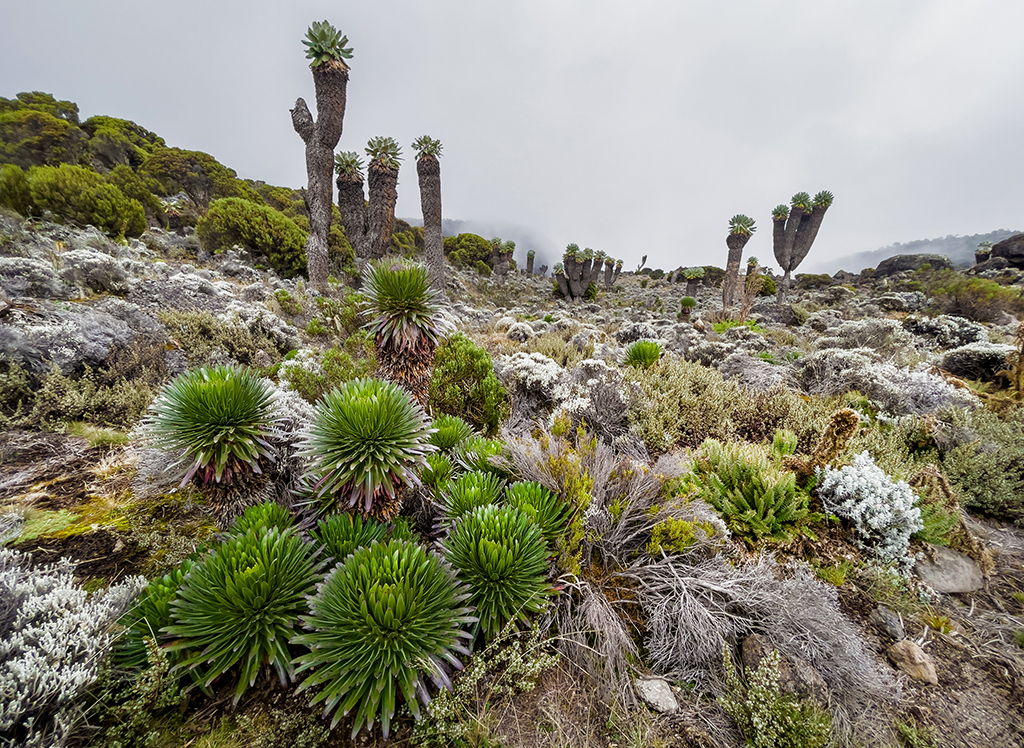
Plant species in the Heath/Moorland zone
The plant life exists in the zone of tussock grasses and herbs is extremely dense. There are many tree varieties which include Hypericum, Albizia, and Elaeodendron but because of the extremes of temperature and the frequent fires caused by lightning, their existence is precarious and stunted. There is a high degree of endemism in the perennial tussock grasses and other grass varieties in this zone. Legumes are also very evident. The most remarkable plant in the heath zone is the giant rosette plant. This grows very slowly and can take up to 30 years to flower. After flowering, the plant dies and because of this, each flowering plant is a separate generation. This monocarpic characteristic is an evolutionary adaptation that safeguards against the risk of total obliteration of the plant.
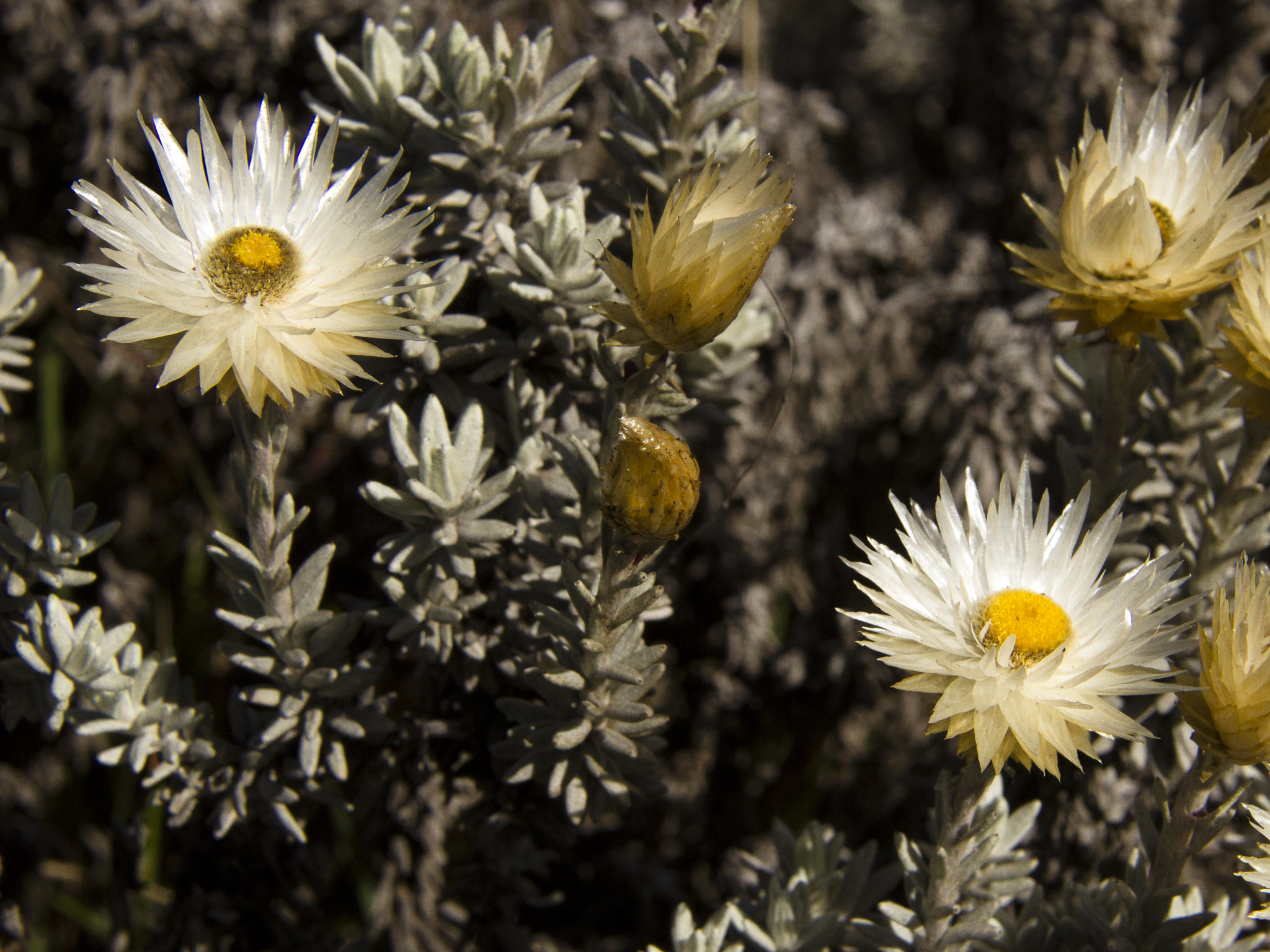
It flowers at heights above 3,000m and the dying plant provides a high-nutrient, moist soil habitat for seedling growth. This plant has a life cycle and form much like that of the giant lobelia in the alpine zone, but it is unrelated and an example of convergent evolution in plants with similar habitats. There are few exploitable resources in this zone but it is used for grazing, honey gathering, and medicinal plant collection. The late-burning fires can cause devastating damage to this ecosystem and in recent years there have been fires that have burnt patches of heathland that are very large, slow to regenerate, and may be changed to an alternative ecosystem. The most significant human impact is the cutting of the giant rosette plants for gardens. Steps are now being taken to conserve this zone of the mountain as it is recognized that most of it is a unique, fragile endemic ecosystem and there are plans to involve the local people in obtaining alternative treeless grazing areas.
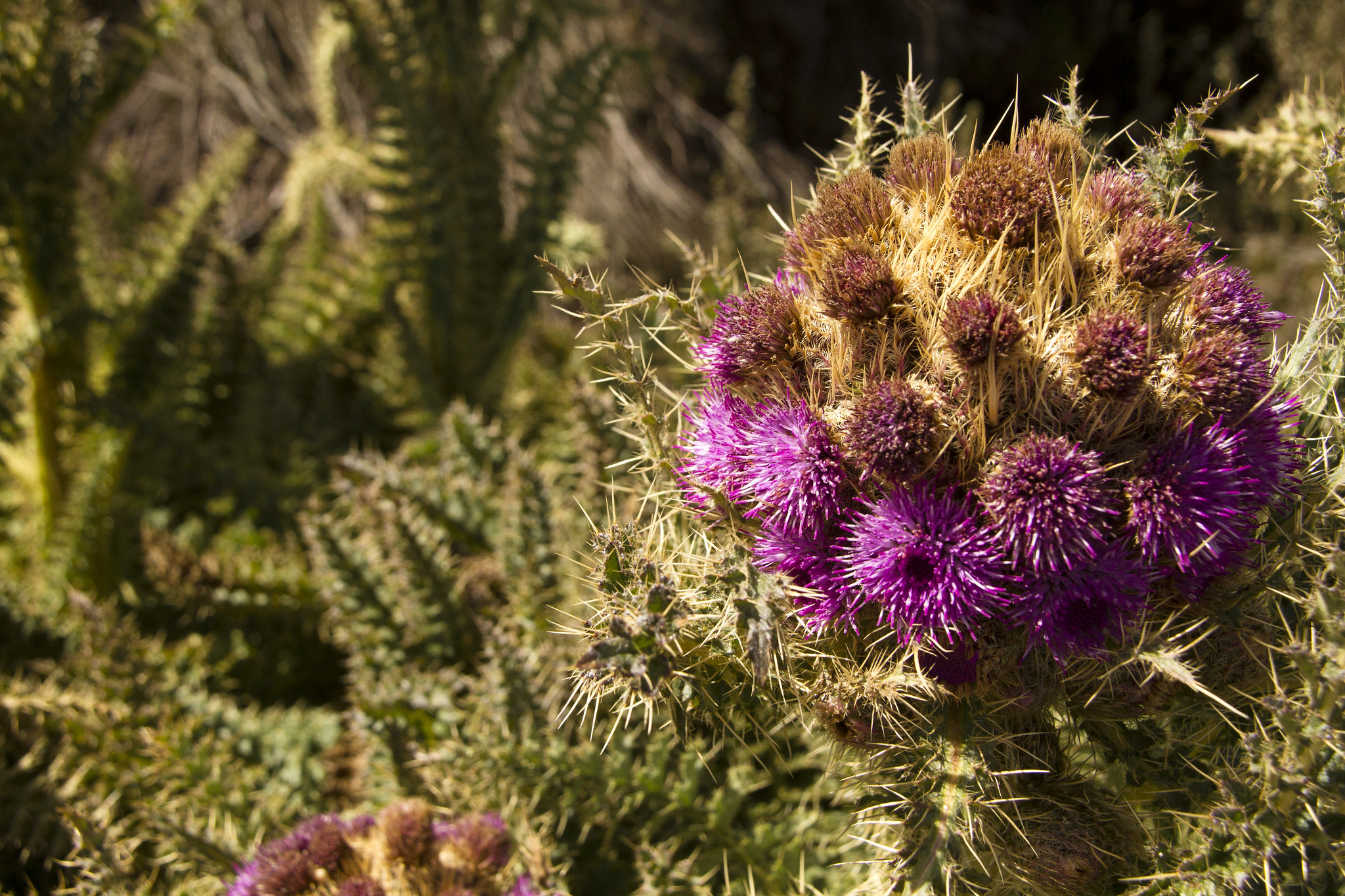
The flora of Kilimanjaro’s Heath/Moorland Zone is characterized by unique plant species adapted to the harsh conditions of high altitude and alpine climates. This zone, situated between approximately 2,800 to 4,000 meters above sea level, experiences cool temperatures, frequent fog, and high winds, creating a challenging environment for plant life. Despite these harsh conditions, the Heath/Moorland Zone supports a diverse array of plant species, each uniquely adapted to survive in this extreme habitat.
- Giant Senecio (Dendrosenecio kilimanjari):
- One of the most iconic plants of Kilimanjaro, the Giant Senecio is a tall, tree-like plant with large rosettes of leaves and yellow flowers.
- Found at higher elevations, the Giant Senecio is adapted to the cold, windy conditions of the Heath/Moorland Zone, where it forms dense stands known as “Senecio forests.”
- Lobelia (Lobelia deckenii):
- A striking plant with large, paddle-shaped leaves and tall spikes of blue-purple flowers, Lobelia thrives in the cool, moist environment of Kilimanjaro’s Heath/Moorland Zone.
- Its unique morphology helps it capture moisture from the air and channel it to the roots, allowing it to survive in the arid conditions of high altitude.
- Helichrysum (Helichrysum newii):
- Also known as the “everlasting flower,” Helichrysum is a hardy perennial herb with small, silver-gray leaves and clusters of yellow flowers.
- Commonly found in rocky slopes and crevices, Helichrysum is well-adapted to the dry, rocky terrain of the Heath/Moorland Zone, where it adds a splash of color to the landscape.
- Tussock Grasses:
- Several species of tussock grasses, including Festuca spp. and Agrostis spp., are found in the Heath/Moorland Zone of Kilimanjaro.
- These grasses form dense clumps or tussocks, providing important habitat and food sources for small mammals and birds adapted to alpine environments.
- Groundsel (Senecio keniodendron):
- Groundsel is a low-growing shrub with silvery leaves and clusters of yellow flowers, resembling a miniature version of the Giant Senecio.
- Thriving in rocky, well-drained soils, Groundsel is a common sight in the Heath/Moorland Zone, where it plays a crucial role in stabilizing soil and preventing erosion.
- Alchemilla (Alchemilla argyrophylla):
- Alchemilla is a genus of flowering plants known for their distinctive lobed leaves and small, greenish-yellow flowers.
- Found in wetter areas of the Heath/Moorland Zone, Alchemilla species are adapted to the cool, moist conditions prevalent at higher elevations on Kilimanjaro.
- Heather (Erica spp.):
- Heather plants, belonging to the genus Erica, are small shrubs with needle-like leaves and clusters of pink, purple, or white flowers.
- Thriving in acidic, nutrient-poor soils, heather species are well-suited to the nutrient-deficient environment of the Heath/Moorland Zone, where they form dense mats of vegetation.
The flora of Kilimanjaro’s Heath/Moorland Zone exhibits remarkable adaptability and resilience, showcasing the diversity of life in this extreme alpine habitat. These plant species play vital roles in ecosystem functioning and provide important habitat and food sources for a variety of wildlife adapted to high altitude environments.
Animal species in the Heath/Moorland zone
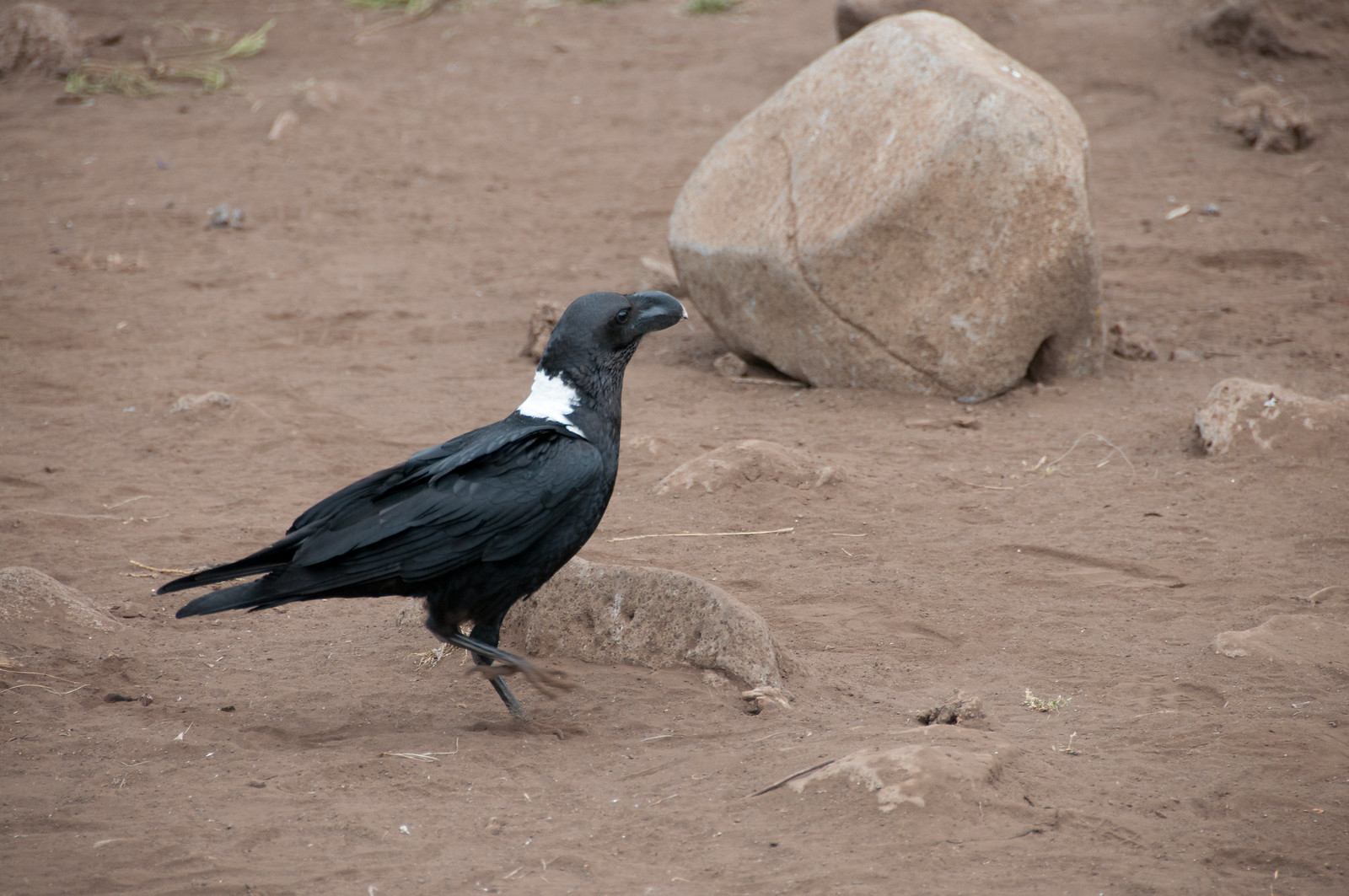 The Heath/Moorland zone of Kilimanjaro, situated between approximately 2,800 to 4,000 meters above sea level, is characterized by its unique flora and fauna adapted to the harsh alpine environment. While the vegetation in this zone may be sparse compared to lower elevations, it still supports a variety of wildlife species, each uniquely adapted to survive in this challenging habitat. Here are some of the notable wildlife species found in the Heath/Moorland zone of Kilimanjaro:
The Heath/Moorland zone of Kilimanjaro, situated between approximately 2,800 to 4,000 meters above sea level, is characterized by its unique flora and fauna adapted to the harsh alpine environment. While the vegetation in this zone may be sparse compared to lower elevations, it still supports a variety of wildlife species, each uniquely adapted to survive in this challenging habitat. Here are some of the notable wildlife species found in the Heath/Moorland zone of Kilimanjaro:
- Rock Hyrax (Procavia capensis):
- Commonly known as “dassies,” rock hyraxes are small, furry mammals that resemble large guinea pigs.
- They are often found sunning themselves on rocky outcrops or hiding among boulders, using their keen sense of smell and agility to evade predators.
- Kilimanjaro Shrew (Crocidura monax):
- The Kilimanjaro shrew is a small insect-eating mammal endemic to the mountain.
- It has adapted to the cold, high-altitude environment of the Heath/Moorland zone, where it forages for insects and other invertebrates among the vegetation.
- Mole Rat (Tachyoryctes splendens):
- Mole rats are burrowing rodents that inhabit the subterranean tunnels and burrows of the Heath/Moorland zone.
- Their underground lifestyle helps them avoid predators and maintain a stable body temperature in the variable alpine climate.
- Mountain Reedbuck (Redunca fulvorufula):
- The mountain reedbuck is a medium-sized antelope adapted to life in mountainous terrain.
- Found grazing on grasses and herbs in the open grasslands and moorlands of Kilimanjaro, these antelope are well-adapted to the rugged slopes and rocky outcrops of the mountain.
- Birds of Prey:
- The Heath/Moorland zone is home to a variety of birds of prey, including eagles, hawks, and falcons.
- These raptors play a crucial role in the ecosystem, controlling populations of small mammals and birds and helping to maintain ecological balance.
- Augur Buzzard (Buteo augur):
- The Augur buzzard is a common sight in the Heath/Moorland zone, soaring on thermal currents in search of prey.
- With its keen eyesight and powerful talons, the Augur buzzard preys on small mammals and birds found in the alpine grasslands and rocky slopes of Kilimanjaro.
- Insects and Arachnids:
- Despite the harsh conditions, the Heath/Moorland zone is home to a variety of insects and arachnids adapted to the alpine environment.
- From butterflies and moths to beetles and spiders, these small but resilient creatures play important roles in pollination, decomposition, and nutrient cycling.
While the wildlife of the Heath/Moorland zone may not be as diverse or abundant as in lower elevations, it is nonetheless adapted to thrive in the challenging conditions of high altitude. Visitors to Kilimanjaro’s Heath/Moorland zone have the opportunity to observe these fascinating creatures in their natural habitat, providing a unique glimpse into the intricate web of life on Africa’s tallest mountain.
Unique adaptations of flora and fauna
Other plants have gone a step further and have taken to growing high in the branches of other plants to obtain moisture from mists and clouds and to avoid the desiccating effects of the ground-level winds. This is poetically known as the strategy and is best developed in the epiphytic plants. These plants have undergone extreme reduction in their root systems, realizing that there are nutrients to be gained from the constant damp and decomposing leaf litter prevalent on the branches of heath zone trees. The lack of ground-level nutrients is no hindrance as there has been no adaptation to soil feeding.
In the harsh inhospitable environment of the heath/moorland zone, only the most specialized and highly adapted plants can survive. These plants have had to make several changes to their lifecycles and methods of survival to carve a niche in this difficult environment. Most heath zone plants have short hardy leaves, and many are small, often growing as compact, ground-hugging rosettes. The small leaf size is an adaptation to reduce water loss, thereby saving water in a zone where water is often in short supply. Being close to the ground also has the effect of reducing exposure to high winds, which can be a destructive force in the heath zone. Plants such as Helichrysum newii have adopted a unique method of reducing water loss by rolling their leaves tightly to reduce leaf surface area exposed. The leaves can then be tightly packed into the center of a rosette, offering further protection against desiccation.
Trekking and Exploration of the Heath/Moorland zone
This zone can be traversed on various routes, but all except the eastern route involve going west from either the Shira Plateau or the southern Flats, which all involve a long westward traverse over very wet ground (which can be impassable), and/or a rise in elevation onto the Saddle. The Saddle is the drier area between Kibo and Mawenzi. The eastern route is from the Chagga village of Marangu, which is located in the southeast of the mountain. This route heads directly to Kibo, but does not offer the best acclimatization because of the relatively low starting point, and the profile of the route does not help with acclimatization either. From the Saddle, trekkers may summit Mawenzi, although this is not advisable due to safety and conservation reasons. The standard ascent of Kibo involves an alpine desert trek from the Saddle on the southeastern side of the peak, and it has excellent acclimatization possibilities, unlike the ascent from the Marangu route. Trekkers will have the option of avoiding the wettest areas if they ascend Kibo from the west and the southern sides of the peak, and spending a night at the very scenic and appropriately named Kibo Huts, which have beautiful views of the areas trekkers have passed on their climb to Kibo, and of the surrounding plains 4000 meters below.
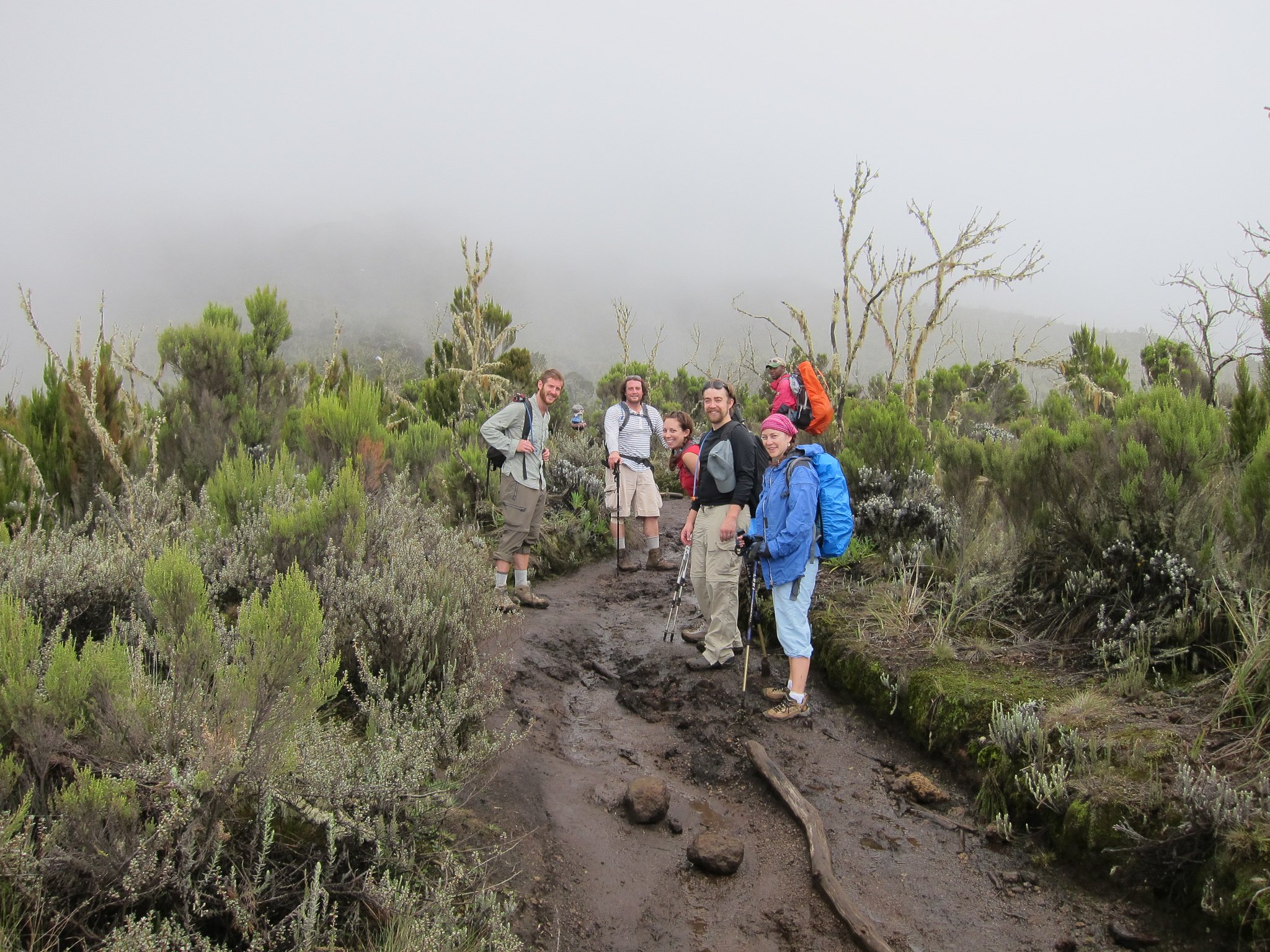
Popular trekking routes through the Heath/Moorland zone
Trekkers ascending the Marangu route, which has a bad reputation amongst guides and tourists for being too busy, consistently fail to provide successful ascents because of a poor acclimatization schedule. This is due to the shortness of the route and the tourist expectation for a quick ascent. However, you can get away from the crowds at the end of day three where the route to Mandara and then onto the Kibo huts diverges from the main route and provides a tranquil walk through the peak’s moorland. People who don’t mind a dent to the pocket can avoid the crowds and increase the probability of a successful summit by adding an extra acclimatization day between the second and third overnight stops. This can be achieved by resting at Horombo or continuing on to the final destination of Kibo but spending an extra night there. The more difficult western Breach route starts from the village of Kilema, an hour’s drive from Moshi. This is the initial stage of the Rongai route but then diverges up to the base of the peak where trekkers will camp in the idyllic setting of the North Circuit on the Pofu Camp. This route provides a more pristine and quieter environment, but as it is more risky, it should ideally be combined in an 11-day trek which includes a rest day before the attempt on the summit. Although the Lemosho route through the west and the Shira route which joins it are more often used by climbers, both pass through the moorland on the west of the peak and can be quite rewarding due to the expanse and quieter environment compared to the other routes.
Characteristics of the Heath/Moorland Zone
Both the heath and moorland environments have similarities but also some distinct differences. Heath is typically found in regions with a more moderate climate. It consists of open, uncultivated land with poor soils, making it suitable for the growth of shrubs like heather and other low-growing, woody vegetation. Heathlands are associated with lower levels of precipitation and moisture, resulting in less humid conditions. The plant life in these areas is well adapted to the drier and less fertile conditions. On the other hand, moorland is commonly found in upland areas. It experiences higher levels of precipitation and the soil retains more moisture, leading to higher humidity levels. Moorlands support a variety of vegetation, including grasses, mosses, and heather. They can even include blanket bogs and peatlands. In the heath/moorland zone, plant life is sparsely distributed. The plants here are hardier and more resistant to drought compared to those in lower zones, as they have adapted to the cooler temperatures and lower moisture levels. Wildlife is also less abundant in the heath/moorland environment compared to the rainforest. Smaller mammals, bird species, and insects can be found living amidst the thin vegetation and open spaces.
The Environmental Role of the Heath/Moorland Zone
Heath and moorland zones play a crucial role in regulating water within an ecosystem. Moorlands, known for their peaty soils, act as natural sponges by soaking up rainfall and slowly releasing it over time. This not only helps to regulate river flows but also decreases the risk of floods downstream. Furthermore, these areas have the ability to enhance water quality by filtering out pollutants and sediments as water passes through the soil, thereby contributing to cleaner rivers and lakes. Moorland zones often feature peatlands, which are highly valuable as carbon sinks. The peat soil, formed by partially decomposed vegetation, has the capacity to capture and store carbon dioxide that would otherwise be released into the atmosphere. As a result, heath and moorland zones serve as an effective means of mitigating climate change by effectively sequestering carbon. Lastly, the vegetation cover found in heath and moorland zones provides essential protection against soil erosion. The roots of heather and other moorland plants bind the soil together, minimizing the impacts of erosion caused by wind and water. This protective measure is particularly important in upland areas, where soil loss can lead to degradation of the landscape and have detrimental effects on water quality and biodiversity.
Tips for Tackling Kilimanjaro’s Heath/Moorland Zone
The majority of the routes to Kilimanjaro pass through this particular section of the mountain on the second day of the trip and remain there for a duration of 1 to 2 days. Here are a few recommendations on effectively navigating the heath/moorland zone of Mount Kilimanjaro:
Block the Wind – Moving from the densely packed, moist rainforest region to the spacious and breezy heath or moorland area entails a reduction in protection from the natural forces. Adventurers must brace themselves for lower temperatures and more forceful winds. Equipping themselves with a sturdy outer layer made of tough material will provide the necessary defense against the cold air.
Protect Yourself from the Sun – In the same way, the shade within the forest has disappeared. The elevated elevation and diluted atmosphere result in an increased exposure to ultraviolet rays. To safeguard oneself against sunburn, it is imperative to use sunscreen, wear a broad-brimmed hat, and don sunglasses. Take a moment to marvel at the distinctive flora present in this area, as it showcases some truly astonishing manifestations of nature’s resilience. See our Kilimanjaro gear list here
Acclimatization: As climbers venture into this zone, they may begin to experience the detrimental impacts of high altitude. Therefore, it is important to remain mindful of the symptoms of acute mountain sickness and diligently adhere to our acclimatization guidelines. Learn how to properly acclimatize
Highlights and attractions for explorers
The western side offers better views of the spectacular Shira Plateau than the western routes. The trail is not at all crowded until the junction with the Lemosho route. The walk across the Plateau is high and interesting. The camp area has a larger space for camping and you might see large groups attempting the summit from there. Lemosho is the best route for people who are looking for a personal wilderness experience on an untouched track. Summit attempts from Lemosho can use Barafu or the Western Breach route. Although the descent is the Mweka route, the scenery is not repeated as the forest section is off an alternative route to the east. The Western Breach route is not for everyone and can be very dangerous and somewhat technical. This should only be attempted by experienced trekkers with the right equipment and support, not to mention the additional cost.
Weather and temperature of the Heath and Moorland zone of Kilimanjaro
In the Heath/Moorland zone of Mount Kilimanjaro, the weather and temperature can vary significantly depending on the time of day and the season. During the daytime, temperatures typically range from 10 to 20 degrees Celsius (50 to 68 degrees Fahrenheit). However, temperatures can drop significantly at night, often falling below freezing, especially at higher elevations.
The weather in this zone is characterized by its unpredictability, with rapid changes possible throughout the day. It is not uncommon to experience sunshine, rain, fog, and even hail within a short period. Trekkers should be prepared for sudden weather shifts and dress in layers to accommodate temperature fluctuations.
Additionally, strong winds are common in the Heath/Moorland zone, particularly in the afternoon and evening. These winds can make hiking more challenging, especially on exposed ridges and slopes. It’s essential for trekkers to be aware of weather conditions and take appropriate precautions to ensure their safety while exploring this unique ecosystem on Mount Kilimanjaro.
![]()

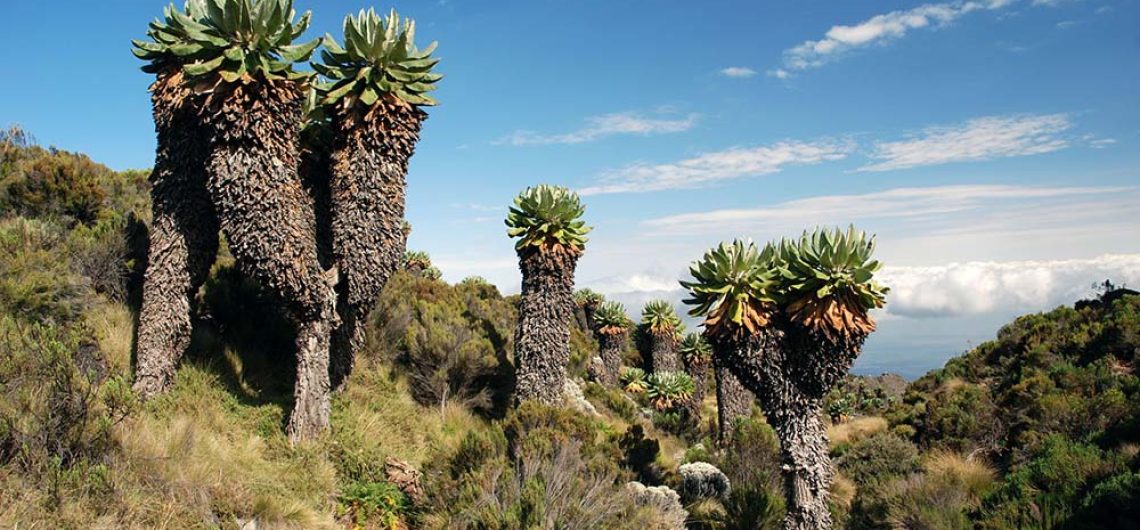
Comments